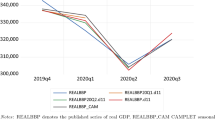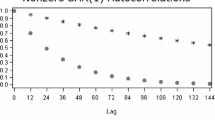Summary
The evaluation of the performance of seasonal adjustment procedures is an issue of practical importance in view of the unobservable nature of the components. Looking at just one indicator when judging the overall quality of a procedure may be misleading, even though this is common practice when many series are involved.
The main purpose of this paper is to compare the information content of different synthetic indicators with reference to the X-11-ARIMA procedure.
Sixty-six different types of monthly seasonal series are generated and the seasonal component then extracted by carrying out X-11-ARIMA with standard options. The correlation between the pseudo-true error for each series and various synthetic indicators allows us to compare the latter's reliability, under both the hypotheses of minimum and maximum variance of the pseudo-true seasonal component.
We show that the overall quality indexQ-the indicator most commonly adopted by users of the X-11-ARIMA-is always outperformed by the simpler diagnostics based on the stability of the estimates.
In particular, the “sliding-spans” indicator, proposed by Findley et al. (1990) and included in the diagnostics of the new X-12 procedure, shows a much stronger correlation with the pseudo-true error in the seasonal adjustment.
We also show that the total forecasting errors in the one-year-ahead extrapolation of the seasonal component have a good informative power and perform almost as well as the “sliding-spans” indicator.
Similar content being viewed by others
References
Bacchilega G. andGambetta, G. (1984).Appunti per un confronto empirico tra diversi metodi di depurazione stagionale, Centro di Specializzazione e Ricerche. Portici, RS 16/84.
Bell, W. R. andHillmer, S. C. (1984). Issues Involved with the Seasonal Adjustment of Economic Time Series,Journal of Business and Economic Time Series, 2, 91–349.
Box, G. E. P., Hillmer, S. C. andTiao, G. C. (1978). Analysis and Modeling of Seasonal Time Series. InSeasonal Analysis of Economic Time Series, ed. A. Zellner, US Department of Commerce, 320.
Box G. E. P. andJenkins, G. M. (1970).Time Series Analysis: Forecasting and Control, San Francisco, Holden-Day.
Burman, J. P. (1967). Assessment of a Seasonal Adjustment Procedure by Spectral Analysis,Statistician, 247–256.
Burman, J. P. (1980), Seasonal Adjustment by Signal Extraction, Journal of the Royal Statistical Society, A, 321–37.
Burridge, P. andWallis, K. F. (1984). Unobserved-Components Models for Seasonal Adjustment Filters,Journal of Business and Economic Statistics, 2, 350–9.
Cleveland, W. P. andTiao, G. C. (1976). Decomposition of Seasonal Time Series: A Model for the Census X-11 Program,Journal of the American Statistical Association, 71, 581–7.
Dagum, E. B. (1987). Current Issues on Seasonal Adjustment, Working Paper-TSRA 87/6, Statistics Canada, Ottawa.
Dagum, E. B. (1988).The X-11-ARIMA/88 Seasonal Adjustment Method, Statistics Canada, Catalogue K1A OT6.
Dagum, E. B., Chab, N. andSolomon, B. (1991). The Autocorrelation of Residuals from the X-11-ARIMA Method,Journal of Officials Statistics, 7, 181–194.
Engle, R. F. andGranger, C. W. J. (1987). Cointegration on Error Correction: Representation, Estimation and Testing,Econometrica, 55, 251–276.
Findley, D. F. andMonsell, B. C. (1986). New Techniques for Determining if a Time Series Can Be Seasonally Adjusted Reliably. InRegional Econometric Modelling, eds. M. R. Perryman e G. R. Schimdt, Amsterdam, Kluwer-Nijhoff, 195–228.
Findley, D. F., Monsell, B. C., Shulman, H. B. andPugh, M. G. (1990). Sliding-Spans Diagnostics for Seasonal and Related Adjustments,Journal of the American Statistical Association, Vol. 85, N. 410, 345–55.
Ghysels, E., Granger, C. W. J. andSiklos, P.L. (1996). Is Seasonal Adjustment a Linear or Nonlinear Data-Filtering Process?,Journal of the Business and Economic Statistics, Vol. 14, N. 3, 374–86.
Grether, D. M. andNerlove, M. (1970). Some, Properties of “Optimal” Seasonal Adjustment,Econometrica, 38, 682–703.
Hylleberg, S. (1996) Comments on Ghysels E., Granger C. W. J. and Siklos P. L. (1996), Is Seasonal Adjustment a Linear or Nonlinear Data-Filtering Process?,Journal of the Business and Economic Statistics, Vol. 14, N. 3, 388–89.
Hillmer, S. C. andTiao, G. C. (1982). An ARIMA-Model-based Approach to Seasonal Adjustment,Journal of American Statistical Association, 77, 63–70.
Lothian, J. andMorry, M. (1978). A Set of Quality Control Statistics for the X-11-ARIMA Seasonal Adjustment Program, Research Paper, Statistics Canada.
Lovell, M. C. (1963). Seasonal Adjustment of Economic Time Series and Multiple Regression Analysis,Journal of the American Statistical Association, 58, 993–1010.
Maravall, A. (1987). Minimum Mean Squared Error Estimation of the Noise in Unobserved Component Models,Journal of Business and Economic Statistics, 5, 115–120.
Maravall, A. andGomez, V. (1992). Signal Extraction in ARIMA Time Series. Program SEATS, European University Working Paper, n. 92/65.
Pierce, D. A. (1978). Seasonal Adjustment when both Deterministic and Stochastic Seasonality are Present. InSeasonal Analysis of Economic Time Series, ed. A Zellner, US Department of Commerce, 242.
Piccolo, D. (1985). Progetto DESEC: un'esperienza di ricerca statistica sulle serie stagionali,Quadërni di Statistica e econometria, VII, 5–40.
Sims, C. A. (1978). Comments on “Seasonality: Causation, Interpretation and Implications” by Clive W. J. Granger. InSeasonal Analysis of Economic Time Series, ed. A. Zellner Washington D.C., US Dept of Commerce, Bureau of the Census.
Tukey, J. W. (1978). Comments on “Seasonality: Causation, Interpretation and Implications” by Clive W. J. Granger. InSeasonal Analysis of Economic Time Series, ed. A. Zellner Washington D. C., US Dept of Commerce, Bureau of the Census.
Wallis, K. F. (1982). Seasonal Adjustment and Revision of Current Data: Linear Filters for the X-11 Methods,Journal of the Royal Statistical Society, A, 145, 74–85.
Author information
Authors and Affiliations
Rights and permissions
About this article
Cite this article
Battipaglia, P. A comparison of indicators for evaluating x-11-arima seasonal adjustment. J. It. Statist. Soc. 5, 179–202 (1996). https://doi.org/10.1007/BF02589171
Issue Date:
DOI: https://doi.org/10.1007/BF02589171




